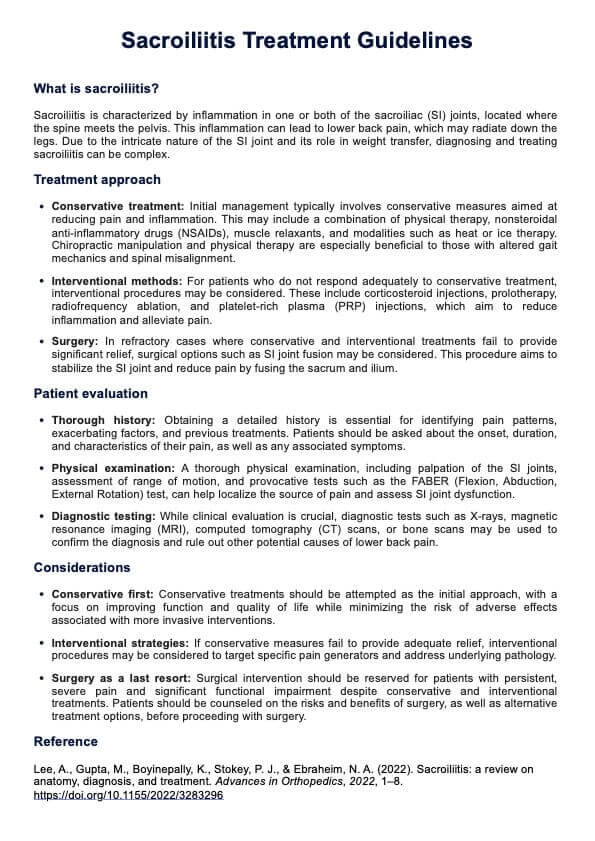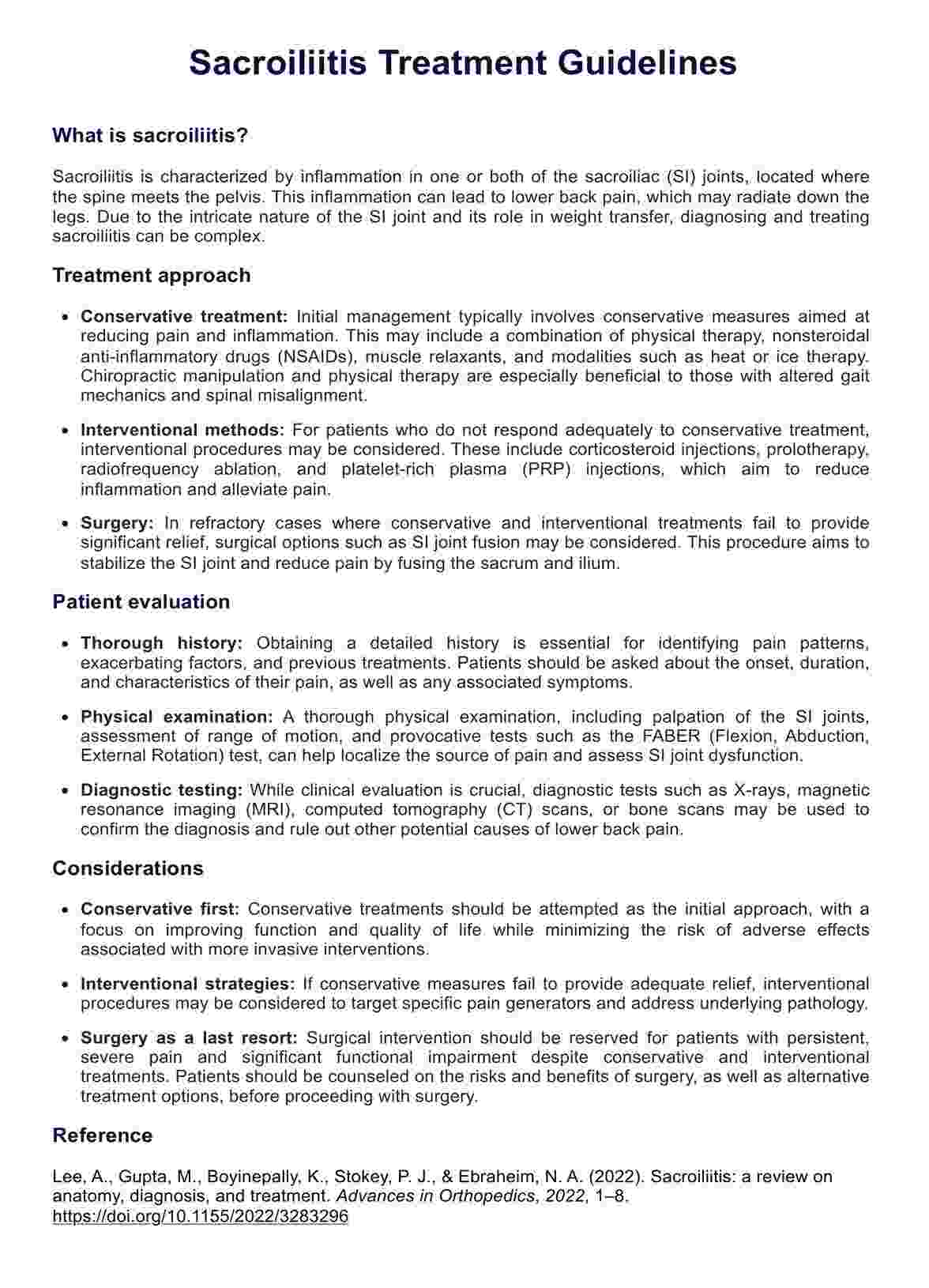Sacroiliitis Treatment Guidelines Handout
Learn about the treatment guidelines for sacroiliitis with Carepatron's free PDF download handout. Get examples and practical tips for managing this condition effectively.


What is sacroiliitis?
According to Lee, Gupta, et. al (2022), sacroiliitis is a condition characterized by inflammation in one or both of the sacroiliac joints, often resulting in sacroiliac (SI) joint pain. The sacroiliac joint, located where the spine meets the pelvis, play a crucial role in supporting the upper body and transferring weight between the spine and lower limbs. When sacroiliac joint dysfunction occurs, it can lead to various symptoms, including sacroiliac pain, buttock pain, and chronic low back pain.
Several underlying conditions can contribute to sacroiliitis, including ankylosing spondylitis, psoriatic arthritis, and other forms of inflammatory arthritis. The inflammation associated with sacroiliitis can cause stiffness and discomfort, particularly during movement or prolonged periods of sitting or standing.
Treating SI joint pain and relieving sacroiliitis pain typically involves a combination of approaches, including medication, physical therapy, and lifestyle modifications. Anti-inflammatory medications may help reduce inflammation and alleviate symptoms, while physical therapy can strengthen the muscles surrounding the sacroiliac joints and improve flexibility.
In some cases, corticosteroid injections may be recommended to provide temporary relief from sacroiliitis pain. Additionally, lifestyle changes such as maintaining a healthy weight and practicing proper posture can help manage symptoms and prevent flare-ups of sacroiliitis.
Sacroiliitis symptoms
Sacroiliitis manifests through various symptoms, indicating inflammation or dysfunction in the sacroiliac joints. Recognizing these symptoms is crucial for timely diagnosis and treatment. Here are the common signs of sacroiliitis:
- Pain: Persistent pain in the lower back, buttocks, hips, or groin is a hallmark symptom of sacroiliitis. The pain may worsen with movement or prolonged sitting or standing.
- Stiffness: Individuals with sacroiliitis often experience stiffness, particularly after periods of inactivity or upon waking in the morning.
- Radiating pain: Pain from the sacroiliac joints can sometimes radiate down the legs, mimicking sciatica.
- Reduced range of motion: Limited flexibility and difficulty performing certain movements, such as bending or twisting, may occur due to sacroiliitis.
- Inflammation: Swelling and tenderness around the sacroiliac joints can accompany sacroiliitis, indicating ongoing inflammation.
- Pain aggravation: Certain activities, such as climbing stairs, standing on one leg, or transitioning from sitting to standing, may exacerbate sacroiliitis pain.
Recognizing these symptoms can prompt individuals to seek medical evaluation and appropriate treatment for sacroiliitis.
Causes of sacroiliitis
Sacroiliitis can stem from various underlying causes, often related to inflammation or dysfunction in the sacroiliac joints. One primary cause is inflammatory arthritis, including conditions such as ankylosing spondylitis and arthritis. In these autoimmune disorders, the body's immune system mistakenly attacks the joints, leading to inflammation and pain.
Physical trauma or injury to the sacroiliac joints can also trigger sacroiliitis. Activities or accidents that result in direct impact or repetitive stress on the pelvis can damage the ligaments and cartilage surrounding the sacroiliac joints, leading to inflammation and discomfort.
Additionally, infections, such as those caused by bacteria or viruses, can sometimes affect the sacroiliac joints, resulting in sacroiliitis. These infections may spread to the joints from nearby tissues or organs, leading to inflammation and pain.
Sacroiliitis Treatment Guidelines Handout Template
Sacroiliitis Treatment Guidelines Handout Example
How do healthcare professionals treat sacroiliitis?
Healthcare professionals employ various treatment approaches to alleviate sacroiliitis symptoms and improve the quality of life for affected individuals. Here are some common treatments:
Medications
Medications are often used to manage sacroiliitis symptoms, including pain and inflammation. Nonsteroidal anti-inflammatory drugs (NSAIDs) such as ibuprofen or naproxen can help reduce inflammation and relieve pain associated with sacroiliitis. In more severe cases, corticosteroid injections may be administered directly into the sacroiliac joint to provide targeted relief.
Physical therapy
Physical therapy plays a crucial role in treating sacroiliitis by improving strength, flexibility, and joint function. Therapeutic exercises tailored to address symptoms can help strengthen the muscles surrounding the sacroiliac joint, improve posture, and reduce pain. Additionally, techniques such as manual therapy and modalities like heat or ice therapy may be used to alleviate discomfort and promote healing.
Biologic therapies
For individuals with sacroiliitis caused by autoimmune conditions like ankylosing spondylitis or arthritis, biologic therapies may be recommended. Biologics are medications that target specific components of the immune system involved in inflammation. These treatments can help reduce inflammation in the sacroiliac joint and alleviate symptoms.
Lifestyle modifications
Certain lifestyle changes can help manage symptoms and improve overall well-being. Maintaining a healthy weight, practicing good posture, and avoiding activities that exacerbate symptoms can help reduce strain on the sacroiliac joint and prevent flare-ups of sacroiliitis pain. Additionally, incorporating regular exercise, such as low-impact activities like swimming or yoga, can help strengthen muscles and improve joint mobility.
Minimally invasive procedures
In cases where conservative treatments fail to provide sufficient relief, minimally invasive procedures such as radiofrequency ablation or sacroiliac joint injections may be considered. These procedures aim to disrupt the pain signals from the sacroiliac joint, providing long-lasting pain relief for individuals with chronic sacroiliitis pain.
How healthcare professionals will benefit from this handout
Our Sacroiliitis Treatment Guidelines Handout offers healthcare professionals invaluable tools to optimize patient care and enhance clinical practice. Below are five key benefits that healthcare professionals can expect from utilizing this resource:
Enhanced patient education
Provide patients with clear and comprehensive information about sacroiliitis and its management, empowering them to actively participate in their treatment plan.
Streamlined treatment planning
Facilitate efficient communication of evidence-based treatment recommendations, ensuring consistency and coherence in patient care strategies.
Improved patient outcomes
Promote early diagnosis and targeted intervention, leading to symptom relief, functional improvement, and enhanced quality of life for patients with sacroiliitis.
Facilitated collaboration
Foster collaborative decision-making between healthcare providers and patients, facilitating informed discussions about treatment options, including conservative measures, interventional procedures, and surgical interventions like joint fusion.
Reduced treatment variability
Minimize variability in sacroiliitis management by standardizing treatment approaches and ensuring adherence to best practices, ultimately optimizing patient outcomes and satisfaction.
References
Lee, A., Gupta, M., Boyinepally, K., Stokey, P. J., & Ebraheim, N. A. (2022). Sacroiliitis: a review on anatomy, diagnosis, and treatment. Advances in Orthopedics, 2022, 1–8. https://doi.org/10.1155/2022/3283296
Commonly asked questions
Sacroiliitis joint pain treatment typically involves a combination of medication, physical therapy, lifestyle modifications, and, in some cases, interventional procedures to reduce inflammation and manage symptoms effectively.
Nonsteroidal anti-inflammatory drugs (NSAIDs) are commonly used to alleviate pain and reduce inflammation associated with sacroiliitis. However, consult with a healthcare professional for personalized recommendations.
Sacroiliac joint pain can be a chronic condition, but with proper treatment and management, symptoms can be controlled, and individuals can experience long-term relief.
The healing time for sacroiliitis varies depending on factors such as the severity of inflammation, individual response to treatment, and adherence to recommended therapies. It's essential to follow a comprehensive treatment plan for optimal recovery.







































































































